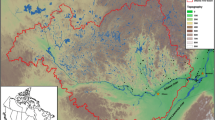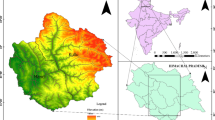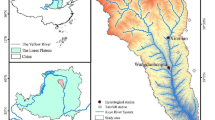Abstract
Flood is among the deadliest disasters in India, and the frequency of floods and extreme precipitation events is projected to increase under the warming climate. The frequency of floods in India varies geographically as some regions are more prone to floods than the others. The Kerala flood of 2018 caused enormous economic damage, affected millions of people, and resulted in the death of more than 400 people. Here we provide a hydroclimatological perspective on the Kerala flood of 2018. Using the observations and model simulations from the Variable Infiltration Capacity (VIC) model, we show that the 2018 extreme precipitation and runoff conditions that caused flooding were unprecedented in the record of the past 66 years (1951–2017). Our results show that mean monsoon precipitation has significantly declined while air temperature has significantly increased during 1951–2017 in Kerala. The drying and warming trends during the monsoon season resulted in a declined total runoff in large part of the state in the last 66 years. Apart from the mean hydroclimatic conditions, extreme precipitation, and extreme total runoff have also declined from 1951 to 2017. However, 1 and 2-day extreme precipitation and extreme runoff conditions in August 2018 exceeded substantially from the long-term 95th percentiles recorded during 1951–2017. Since there is no increase in mean and extreme precipitation in Kerala over the last six decades, the extreme event during August 2018 is likely to be driven by anomalous atmospheric conditions due to climate variability rather anthropogenic climate warming. The severity of the Kerala flood of 2018 and the damage caused might be affected by several factors including land use/land cover change, antecedent hydrologic conditions, reservoir storage and operations, encroachment of flood plains, and other natural factors. The impacts of key drivers (anthropogenic and natural) on flood severity need to be established to improve our understanding of floods and associated damage.
Similar content being viewed by others
References
Aadhar, S. and Mishra, V. (2017) High-resolution near real-time drought monitoring in South Asia. Scientific Data, 4, 170145. DOI:10.1038/sdata.2017.145
Boyaj, A., Ashok, K., Ghosh, S., Devanand, A. and Dandu, G. (2018) The Chennai extreme rainfall event in 2015: The Bay of Bengal connection. Climate Dynamics. DOI:10.1007/s00382-017-3778-7
Cherkauer, K.A., Bowling, L.C. and Lettenmaier, D.P. (2003) Variable infiltration capacity cold land process model updates. Global and Planetary Change. DOI:10.1016/S0921-8181(03)00025-0
Franchini, M. and Pacciani, M. (1991) Comparative analysis of several conceptual rainfall-runoff models. Jour. Hydrol. DOI:10.1016/0022-1694(91)90178-K
Frans, C., Istanbulluoglu, E., Mishra, V., Munoz-Arriola, F. and Lettenmaier, D.P. (2013) Are climatic or land cover changes the dominant cause of runoff trends in the Upper Mississippi River Basin? Geophys. Res. Lett. DOI:10.1002/grl.50262
Goswami, B.N., Venugopal, V., Sangupta, D., Madhusoodanan, M.S. and Xavier, P.K. (2006) Increasing trend of extreme rain events over India in a warming environment. Science. DOI:10.1126/science.1132027
Gulf News. (30 August 2018) Kerala flood live: Hundreds dead, hundreds of thousands homeless, clean-up drive starts | GulfNews.com. Retrieved from https://gulfnews.com/news/asia/india/kerala-flood-livehundreds-dead-hundreds-of-thousands-homeless-clean-up-drive-starts-1.2268422
Gupta, A.K. and Nair, S.S. (2011) Urban floods in Bangalore and Chennai: Risk management challenges and lessons for sustainable urban ecology. Curr. Sci. DOI:10.1016/j.ajodo.2005.02.022
Kumar, A. (2013) Demystifying a Himalayan tragedy: study of 2013 Uttarakhand disaster. Jour. Indian Res., v.1(3), pp.106–116. Retrieved from http://mujournal.mewaruniversity.in/jir3/jir3.pdf#page=114
Liang, X., Wood, E.F. and Lettenmaier, D.P. (1996). Surface soil moisture parameterization of the VIC-2L model: Evaluation and modification. Global and Planetary Change. DOI:10.1016/0921-8181(95)00046-1
Maurer, E.P., Wood, A.W., Adam, J.C., Lettenmaier, D.P. and Nijssen, B. (2002) A Long-Term Hydrologically Based Dataset of Land Surface Fluxes and States for the Conterminous United States. Jour, Climate, v.15(22), pp.3237–3251.
Mishra, V., Aaadhar, S., Shah, H., Kumar, R., Pattanaik, D.R. and Tiwari, A. D. (2018) The Kerala flood of 2018: combined impact of extreme rainfall and reservoir storage. Hydrology and Earth System Sciences Discussions, pp.1–13. DOI:10.5194/hess-2018-480
Mishra, V., Cherkauer, K.A., Niyogi, D., Lei, M., Pijanowski, B. C., Ray, D.K., Yang, G. (2010) A regional scale assessment of land use/land cover and climatic changes on water and energy cycle in the upper Midwest United States. Internat. Jour. Climatology. DOI:10.1002/joc.2095
Mishra, V. and Lettenmaier, D.P. (2011) Climatic trends in major U.S. urban areas, 1950–2009. Geophys. Res. Lett. DOI:10.1029/2011GL048255
Mishra, V., Shah, R., Azhar, S., Shah, H., Modi, P. and Kumar, R. (2018) Reconstruction of droughts in India using multiple land surface models (1951-2015) Hydrology and Earth System Sciences. DOI: 10.5194/hess-22-2269-2018
Mishra, V., Shah, R. and Thrasher, B. (2014). Soil Moisture Droughts under the Retrospective and Projected Climate in India. Jour. Hydrometeorology. DOI:10.1175/JHM-D-13-0177.1
Mukherjee, S., Aadhar, S., Stone, D. and Mishra, V. (2018) Increase in extreme precipitation events under anthropogenic warming in India. Weather and Climate Extremes. DOI:10.1016/j.wace.2018.03.005
Pai, D.S., Sridhar, L., Badwaik, M.R. and Rajeevan, M. (2015) Analysis of the daily rainfall events over India using a new long period (1901–2010) high resolution (0.25° × 0.25°) gridded rainfall data set. Climate Dynamics. DOI:10.1007/s00382-014-2307-1
Paul, S., Ghosh, S., Rajendran, K. and Murtugudde, R. (2018) Moisture Supply From the Western Ghats Forests to Water Deficit East Coast of India. Geophys. Res. Lett. DOI:10.1029/2018GL078198
Rajeevan, M., Bhate, J., Kale, J. D. and Lal, B. (2006) High resolution daily gridded rainfall data for the Indian region: Analysis of break and active monsoon spells. Curr. Sci. DOI: 10.1007/s12040-007-0019-1
Roxy, M.K., Ghosh, S., Pathak, A., Athulya, R., Mujumdar, M., Murtugudde, R. and Rajeevan, M. (2017) A threefold rise in widespread extreme rain events over central India. Nature Communications. DOI:10.1038/s41467-017-00744-9
Shah, H.L. and Mishra, V. (2016a) Hydrologic Changes in Indian Subcontinental River Basins (1901–2012). Jour. Hydrometeorology, v.17(10), pp.2667–2687. DOI:10.1175/JHM-D-15-0231.1
Shah, H.L. and Mishra, V. (2016b) Uncertainty and Bias in Satellite-Based Precipitation Estimates over Indian Subcontinental Basins: Implications for Real-Time Streamflow Simulation and Flood Prediction. Jour. Hydrometeorology, v.17(2), pp.615–636. DOI:10.1175/JHM-D-15-0115.1
Shah, R.D. and Mishra, V. (2015) Development of an Experimental Near-Real-Time Drought Monitor for India. Jour. Hydrometeorology. DOI: 10.1175/JHM-D-14-0041.1
Shah, R. and Mishra, V. (2014) Evaluation of the Reanalysis Products for the Monsoon Season Droughts in India. Jour. Hydrometeorology. DOI:10.1175/JHM-D-13-0103.1
Srivastava, A.K., Rajeevan, M. and Kshirsagar, S.R. (2009) Development of a high resolution daily gridded temperature data set (1969–2005) for the Indian region. Atmospheric Sci. Lett., v.10(4), pp.249–254.
Van Oldenborgh, G. J., Otto, F. E. L., Haustein, K. and Achutarao, K. (2016) The heavy precipitation event of December 2015 in Chennai, India. Bull. Amer. Meteorological Soc. DO:10.1175/BAMS-D-16-0129.1
Wood, E.F., Lettenmaier, D.P. and Zartarian, V.G. (1992). A land-surface hydrology parameterization with subgrid variability for general circulation models. Jour. Geophys. Res. DOI:10.1029/91JD01786
Author information
Authors and Affiliations
Corresponding author
Rights and permissions
About this article
Cite this article
Mishra, V., Shah, H.L. Hydroclimatological Perspective of the Kerala Flood of 2018. J Geol Soc India 92, 645–650 (2018). https://doi.org/10.1007/s12594-018-1079-3
Published:
Issue Date:
DOI: https://doi.org/10.1007/s12594-018-1079-3




